




|
 |
 |
  |
|
 |
| This science module focuses on the origin
and evolution of the universe. If you are using Genesis
science modules for the first time, read the User's
Guide thoroughly before you begin. (View User's Guide
as a PDF.)
The Portable Document Format (PDF) is used
to distribute fully formatted, print-quality
documents electronically. The following information
is available to view and print as a PDF file
with Adobe's Acrobat reader. To install the
FREE Adobe Acrobat Reader, visit the Adobe
Web site.
Take a look at other science
modules available. All technical terms
in the science modules are compiled in the Glossary for
easy access. 
Technology
Applications are available for this module.
|
|
|
|
|
|
Adobe's
Acrobat Reader©

The
Portable Document Format (PDF) is used to distribute
fully formatted, print-quality documents. |
|
Teacher Resources |
| For a listing of additional resources
that includes URLs, books, and periodicals, click
here. |
|
|
|
| |
|
|
|
|
|
|
|
|
|
|
|
|
|
 |
|
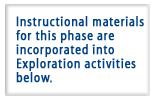 |
|
|
 |
| The primary objective of the Genesis
mission is to collect samples of solar wind particles and return
them to the Earth for detailed analysis. Precise analysis of
these particles will provide solar isotopic and elemental abundances,
and thus will form a basis for testing models of solar system
formation, evolution, and early nebular composition.
These solar system models ultimately must fit in with models
of the formation of the universe, as tiny parts of the whole,
but ones for which comparatively complete data exists. The
information obtained from the Genesis mission pertaining
to the primordial solar system should ultimately prove useful
to cosmologists and cosmogonists, since the solar system
is thought to have originated from a disk-shaped cloud of
gas and dust when the universe was about two-thirds its current
age. Thus, the Genesis mission becomes a part of the necessary
cosmological strategy of working backwards through time toward
a beginning.
|
|
 |
Curriculum
Connections
National Standards Addressed
National
Science Education Standards
Grades 5-8
Science as Inquiry |
- Understandings about scientific inquiry
|
| Physical Science |
- Properties and changes of properties in matter
- Motions and Forces
- Transfer of Energy
|
| Earth and Space
Science |
- Structure of the Earth System
- Earth in the Solar System
- Origin and Evolution of the Universe
|
| Science and
Technology |
- Understandings about Science and Technology
|
| History and
Nature of Science |
- Science as a Human Endeavor
- Nature of Science
- History of Science
|
Curriculum
Connections
National Standards Addressed
National
Science Education Standards
Grades 9-12
Science as Inquiry |
- Abilities necessary to do scientific inquiry
- Understandings about scientific inquiry
|
| Physical Science |
- Structure of Atoms
- Motion and Forces
- Structure and Properties of Matter
- Interactions of Energy and Matter
|
| Earth and Space
Science |
- The Origin and Evolution of the Earth System
- The Origin and Evolution of the Universe
|
| Science and
Technology |
- Understandings about Science and Technology
|
| History and
Nature of Science |
- Science as a Human Endeavor
- Nature of Scientific Knowledge
- Historical Perspectives
|
|
|
|
|
|
|
 |
|
|
|
|
 |
| In the activities of this module,
the teacher's primary role is Socratic. Through effective questioning,
students should become aware of the relationship between what scientists
observe and the theories and models that they develop from the
observations.
The Student Activity, "Mathematical Models," emphasizes
the fact that cosmology is, of necessity, a mathematical science,
and it illustrates the power of mathematics to organize our
thoughts and to direct the course of future investigations.
During this activity, students should be guided to an understanding
of the various kinds of models used by scientists and how observations
are converted into useful logic-based models.
The Student Activity, "Density and Gravity-The Push and
the Pull of the Universe," focuses on the importance of
a very simple concept (gravity) to cosmological thought while
stressing the difficulty of determining the density of something
as vast and poorly defined as the universe. The part of this
activity dealing with gravity is designed to underline the
crucial role that this extremely weak force plays in determining
the structure of the universe.
The Student Activity, "Doppler Effect-Are You Coming
or Going?"  illustrates
the application of a simple technique that has been a mainstay
of cosmological science since the early part of the 20th century.
After students develop a physical model that simulates the
Doppler effect, they proceed to explore some actual cosmic
Doppler data and draw conclusions based on these observations. illustrates
the application of a simple technique that has been a mainstay
of cosmological science since the early part of the 20th century.
After students develop a physical model that simulates the
Doppler effect, they proceed to explore some actual cosmic
Doppler data and draw conclusions based on these observations.
The Student Activity, "Quarks-Getting Down to Fundamentals," focuses
the students' attention on extrapolations into the unknown
by inference. The inferred information is used to build models
consistent with observable contemporary data about fundamental
particles and how this matter relates to the origin of the
universe.
|
|
|
|
|
|
|
|
|
|
|
Use the Student Activities, "A
Spongy Universe" 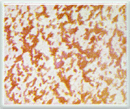 and "Dark
Matter-More Than Meets the Eye" to create interest in learning
more about the structure of the universe and the models that
are now being considered. The "Spongy Universe" activity
emphasizes two things. The
first is that how we view things often depends on our perspective,
and the second is how our view of the universe from here in the
solar system is very limited by our perspective. and "Dark
Matter-More Than Meets the Eye" to create interest in learning
more about the structure of the universe and the models that
are now being considered. The "Spongy Universe" activity
emphasizes two things. The
first is that how we view things often depends on our perspective,
and the second is how our view of the universe from here in the
solar system is very limited by our perspective.
 The "Dark
Matter" activity encourages students to wrestle with the
difficulties faced by scientists when they do not have information
on which to base models. The
activity also focuses on the intellectual developments that
are necessary in order to address these obstacles. The "Dark
Matter" activity encourages students to wrestle with the
difficulties faced by scientists when they do not have information
on which to base models. The
activity also focuses on the intellectual developments that
are necessary in order to address these obstacles. 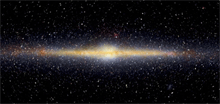
|
|
|
|
|
 |
|
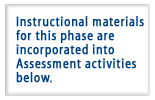
| | |
 |
Students
interact with peers to accomplish the tasks assigned in the 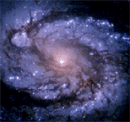 Exploration
and Development sections above. Each activity contains work to
be done in groups, with the whole class participating in preliminary
and summary discussions. Exploration
and Development sections above. Each activity contains work to
be done in groups, with the whole class participating in preliminary
and summary discussions. |
|
|
|
|
 |
|
|
| |
 |
In the assessment activity, "Cosmic
Tug of War," students are asked to decide which of two cosmic
forces (expansion and gravity) will dominate the future of the
universe. In addition to their background from the Exploration
and Development activities of the module, they will use the more
quantitative information in the student text for the Assessment
activity and the references for the module to make and defend
their decisions. Students may also be required to make physical
models of the future universe.
|
|
|
|
|
|
|
|
 |
|
|
|
|
 |
|
|
|
|
|
|
|
|
 |
|
|
|
|
| Writers: |
~Dr. Donna Bogner
~Dr. B.J. McCormick
|
| Contributing Writer: |
~John Ristvey, McREL
|
| Graphics: |
~Judy Counley, McREL
|
| Layout: |
~Susanne Chastain, McREL
~Amy Hoza, McREL
|
|
| Special thanks to the following reviewers: |
~Dr. Gil Yanow, Jet Propulsion Laboratory
~Dr. Monika Kress, NASA Ames Research Center
~Mark Rose, Maplewood Junior & Senior High School, PA
~Alice Krueger, McREL
~Jacinta Behne, McREL
~Deb Jordan, McREL
|
|
|
|
|
|
|
|
|
|
|
|
|
|
|
|
